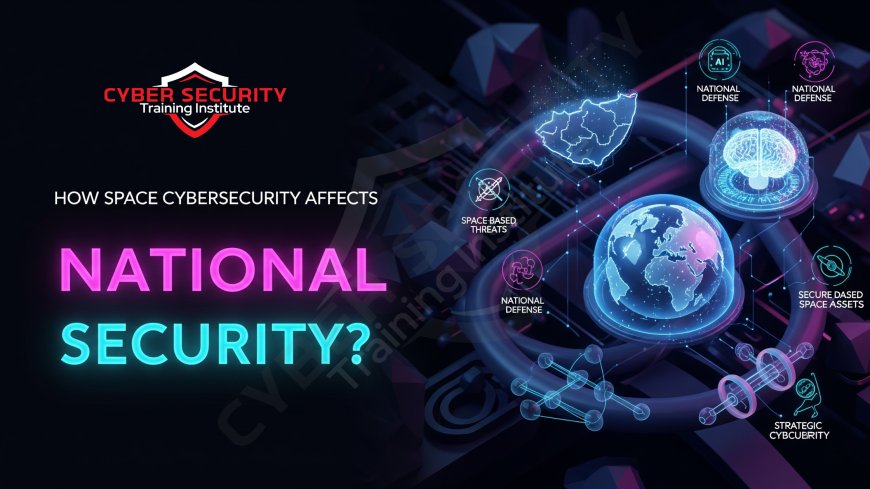How Space Cybersecurity Affects National Security
In our increasingly interconnected world, the lines between terrestrial and extraterrestrial domains are blurring. Space is no longer an exclusive frontier for astronauts and scientists; it is a critical domain that underpins nearly every aspect of modern life, from global communication to financial markets and military operations. This reliance, however, comes with a significant vulnerability: cybersecurity. The security of our space-based assets—satellites, ground stations, and data links—is now intrinsically tied to a nation's ability to function, defend itself, and maintain its position on the global stage. A cyberattack on a satellite is no longer science fiction; it is a very real and growing threat that can have devastating consequences, not only in space but right here on Earth. This blog post explores the profound ways space cybersecurity impacts national security, delving into the threats, the vulnerabilities, and the urgent need for a robust defense strategy in the final frontier.

Table of Contents
- Introduction
- Space as Critical National Infrastructure
- Understanding the Cyber Threats to Space Systems
- The Vulnerable Segments of a Space System
- Cascading Effects on Terrestrial Operations
- The Dual-Use Dilemma
- Strategies for Protecting Space Assets
- The Imperative of International Cooperation
- Conclusion
- Frequently Asked Questions (FAQs)
Space as Critical National Infrastructure
For decades, space was primarily the domain of national governments and military agencies. Today, it has become a bustling hub of commercial activity, with thousands of satellites launched by private companies for everything from satellite internet to earth observation. This shift has integrated space systems into the very fabric of our society. Think about it: GPS, which we use for navigation, is powered by a network of satellites. Weather forecasting, financial transactions, and even the synchronization of global power grids rely on satellite timing signals. This deep integration means that the space sector is no longer just an enabler of national security—it is a critical part of it. A cyberattack that disrupts satellite services can cripple a nation's ability to communicate, navigate, and respond to emergencies, making these systems a prime target for state-sponsored actors, terrorist groups, and even sophisticated cybercriminals.
Understanding the Cyber Threats to Space Systems
The cyber threats to space systems are diverse and sophisticated. They can target any of the four main segments of a space system: the ground segment, the link segment, the space segment, and the user segment. Attackers can employ a range of techniques, from simple jamming to highly complex command and control intrusions.
Table: Common Cyber Threats to Space Systems
| Threat Category | Description | National Security Impact |
|---|---|---|
| Jamming & Spoofing | Overwhelming or sending false signals to disrupt satellite communication and navigation (e.g., GPS spoofing). | Disrupts military navigation, intelligence, surveillance, and reconnaissance (ISR), and can cripple civilian infrastructure dependent on GPS timing. |
| Command and Control Hijacking | Gaining unauthorized access to a satellite’s control systems to manipulate its functions, alter its orbit, or disable it entirely. | Can render a satellite useless, create space debris through a collision, or turn the asset into a weapon. |
| Data Interception & Exfiltration | Intercepting and stealing sensitive data transmitted from a satellite, such as military intelligence or classified communications. | Compromises national intelligence, military secrets, and diplomatic communications. |
| Ground Station Attacks | Targeting the terrestrial infrastructure (ground stations, data centers) that communicate with and control satellites. | Often the weakest link, a successful attack can disrupt an entire constellation of satellites without ever touching the ones in orbit. |
The Vulnerable Segments of a Space System
A space system is not a single, isolated unit. It is a complex network of interconnected components, each with its own vulnerabilities. The **space segment**, the satellite itself, can be targeted through its onboard software and hardware. The **ground segment**, which includes command centers, ground stations, and data processing facilities, is often the most accessible target, as it's connected to terrestrial networks. The **link segment**, the communication pathways between the ground and space, can be disrupted through jamming or spoofing. Finally, the **user segment**, the devices that receive and use satellite data (like GPS receivers), can also be manipulated. A breach in any one of these segments can compromise the entire system, highlighting the need for a holistic cybersecurity approach that protects the entire chain of operations.
The 2022 cyberattack on the Viasat KA-SAT network during the Russian invasion of Ukraine is a stark example of this. The attack, which was attributed to Russia, targeted the ground segment, disrupting satellite internet service for thousands of users in Ukraine and Europe. It demonstrated how a cyberattack on a commercial satellite network can have a direct, real-world impact on a nation's military and civilian communications.
Cascading Effects on Terrestrial Operations
Military Operations and Intelligence
Military forces worldwide are heavily dependent on satellites for critical functions. GPS provides precision navigation for ground troops, naval vessels, and aircraft. Communication satellites enable secure, global communication for command and control. Reconnaissance and surveillance satellites provide vital intelligence on adversary movements and capabilities. An attack that disrupts or denies access to these services can effectively blind and disorient a military, undermining its ability to conduct operations, launch a counterattack, or even defend itself. The ability to control the flow of information and maintain communication superiority in a conflict is paramount, and space cybersecurity is the key to that control. A successful cyberattack on a military satellite could lead to a loss of intelligence, misdirection of forces, and a failure of mission-critical systems, with potentially catastrophic results on the battlefield.
Civilian Critical Infrastructure
Beyond military applications, a cyberattack on space assets can have devastating effects on civilian critical infrastructure. As mentioned earlier, many of these systems rely on satellite-based timing signals (PNT - Positioning, Navigation, and Timing) for synchronization. An attack on PNT signals could disrupt financial markets, shut down power grids, and cause chaos in transportation networks. Imagine a world where all GPS systems suddenly become unreliable, or where the communication networks for emergency services are knocked offline. The consequences would be severe, causing widespread panic, economic collapse, and a humanitarian crisis. This makes space systems a prime target for those who wish to destabilize a nation's economy and social order without firing a single shot.
Economic Stability and Global Commerce
The global economy is deeply intertwined with space-based services. The financial sector, for instance, relies on satellite signals for time stamping transactions with a high degree of accuracy. The logistics industry, from shipping to aviation, uses satellite-based tracking and communication. A cyberattack that compromises these services could lead to widespread financial instability, supply chain disruptions, and significant economic losses. The integrity and reliability of these systems are essential for maintaining global commerce and trade. An adversary could use cyberattacks on space systems to inflict economic damage on a rival nation, creating a new, non-kinetic form of warfare with global repercussions.
The Dual-Use Dilemma
A unique challenge in space cybersecurity is the "dual-use" nature of many space technologies. A satellite system designed for civilian purposes, such as earth observation or communication, can also be used for military intelligence or command and control. This blurring of lines makes it difficult to distinguish between a military and a civilian target in the event of a conflict. It also means that a cyberattack on a seemingly civilian asset can have profound military and national security implications. This dual-use dilemma complicates international relations and the development of norms and treaties for space warfare, as a retaliatory strike against a "civilian" target could be seen as an act of aggression with no clear precedent.
Strategies for Protecting Space Assets
Protecting space assets from cyber threats requires a comprehensive, multi-layered approach. It's not just about securing the satellites themselves. It's about securing the entire system. Key strategies include:
- Secure by Design: Integrating cybersecurity into the entire lifecycle of a space system, from initial design and manufacturing to launch and operation. This means building in security features from the ground up, rather than trying to add them on later.
- Resilient Architecture: Developing space architectures that are resilient to attack. This includes using a mix of different orbits (LEO, MEO, GEO), diversifying the satellite constellation, and building in redundancy so that a failure in one satellite or ground station doesn't cripple the entire system.
- Enhanced Cyber Defenses: Implementing advanced cybersecurity measures on both the ground and in space. This includes strong encryption for data links, robust access controls, intrusion detection systems, and automated responses to cyber anomalies.
- Supply Chain Security: Ensuring the security of the entire supply chain, from the components used to build the satellite to the software that runs it. A single compromised component can create a backdoor for an attacker.
- Real-Time Monitoring and Threat Intelligence: Continuously monitoring all segments of the system for suspicious activity and sharing threat intelligence with allies and partners to stay ahead of emerging threats.
The Imperative of International Cooperation
Cybersecurity is a global challenge, and space cybersecurity is no exception. Given the interconnected nature of space systems and the potential for a single attack to have global repercussions, international cooperation is not a choice—it's a necessity. Nations must work together to establish norms of behavior in space, develop international legal frameworks, and share information on cyber threats. Organizations like the Space Information Sharing and Analysis Center (Space ISAC) play a crucial role in fostering collaboration between government, industry, and academia. By working together, we can create a more secure and resilient space environment that benefits all of humanity.
Conclusion
The security of our space-based infrastructure is a cornerstone of modern national security. From military operations to our daily lives, we are profoundly reliant on satellites and the systems that support them. This reliance has created a new, high-stakes domain of conflict: cyberspace in space. A cyberattack on our space assets can have cascading effects, disrupting critical infrastructure, undermining military capabilities, and destabilizing the global economy. Protecting these assets requires a comprehensive, multi-layered approach that includes technical defenses, resilient architecture, and robust international cooperation. As we continue to push the boundaries of space exploration, we must also recognize that the final frontier is not just a place for discovery, but a new battlefield that requires our utmost attention and protection. The future of national security depends on our ability to secure space, ensuring its continued use for peaceful and beneficial purposes for all.
Frequently Asked Questions (FAQs)
Why is space cybersecurity a national security issue?
Space assets, particularly satellites, are essential for military operations, intelligence gathering, communication, and critical civilian infrastructure like GPS and financial networks. A cyberattack on these systems can cripple a nation's ability to defend itself, disrupt its economy, and cause widespread chaos.
What are the main segments of a space system that can be hacked?
A space system consists of four main segments: the **space segment** (the satellites themselves), the **ground segment** (control centers and ground stations), the **link segment** (communication pathways), and the **user segment** (receivers and applications). An attack can target any of these segments to compromise the entire system.
How can a cyberattack on a satellite affect my daily life?
A cyberattack on a satellite could disrupt services we use daily. This includes navigation systems like GPS, weather forecasting, banking and financial transactions, and even the power grid, which relies on satellite signals for timing and synchronization.
Is it possible to physically damage a satellite with a cyberattack?
While a cyberattack cannot physically destroy a satellite in the same way as a kinetic weapon, it can be used to hijack a satellite's control systems, causing it to alter its orbit, crash into another satellite, or burn up in the atmosphere. This can effectively destroy the satellite and create dangerous space debris.
What is the "dual-use" dilemma in space cybersecurity?
The "dual-use" dilemma refers to the fact that many space technologies have both civilian and military applications. A satellite used for civilian communication could also be used for military command and control, making it a target in a conflict and blurring the lines between military and civilian assets.
What is jamming and spoofing?
Jamming is the act of overwhelming a satellite's communication signal with a stronger, interfering signal. Spoofing is the act of broadcasting a false signal to trick a receiver into thinking it's receiving a legitimate one, such as broadcasting a false GPS signal to mislead navigation systems.
How can a cyberattack on a ground station affect a satellite?
Ground stations are the control centers for satellites. If a ground station is compromised, an attacker can gain unauthorized access to a satellite's command and control systems, allowing them to issue malicious commands, alter its functions, or disable it entirely without ever physically touching the satellite in orbit.
What is the most vulnerable part of a space system?
The ground segment is often considered the most vulnerable part of a space system. Terrestrial networks are often connected to the internet, making them more accessible to attackers than a satellite in orbit. A single successful attack on a ground station can compromise an entire fleet of satellites.
How does the commercialization of space affect cybersecurity?
The rapid commercialization of space has led to a proliferation of satellites and ground systems, which in turn has increased the attack surface. Many commercial space companies may not have the same level of robust security as government agencies, creating new vulnerabilities that can be exploited by adversaries.
Can a cyberattack on a satellite cause a Kessler Syndrome event?
A cyberattack could intentionally cause a satellite to collide with another object, creating a large amount of space debris. If this debris creates a chain reaction of collisions, it could lead to a Kessler Syndrome event, making certain orbits unusable for future space missions, which would be a catastrophic blow to global space capabilities.
What is "Secure by Design" in the context of space cybersecurity?
Secure by Design is an approach to cybersecurity that involves integrating security measures into a space system from the very beginning of its design and development. Instead of treating security as an afterthought, it is a core component of the system's architecture, making it inherently more resilient to attack.
What role does international cooperation play in space cybersecurity?
International cooperation is crucial for establishing global norms of behavior in space, developing legal frameworks, and sharing threat intelligence. Since a cyberattack in space can have global repercussions, no single nation can solve this problem alone.
What is a supply chain attack in space cybersecurity?
A supply chain attack involves an attacker compromising a component or software in the supply chain of a space system. By planting a backdoor or vulnerability in a component during its manufacturing, an attacker can gain a foothold into the system before it is even launched.
How can a cyberattack on a weather satellite affect national security?
A cyberattack on a weather satellite could disrupt a nation's ability to accurately forecast severe weather events, hindering its ability to prepare for and respond to natural disasters. This can lead to significant economic damage and loss of life, affecting a nation's stability and security.
What are some key defense strategies for space systems?
Key defense strategies include building a resilient and redundant system architecture, using strong encryption, implementing real-time threat monitoring and intelligence sharing, and focusing on secure hardware and software development from the start.
Can an attack on a satellite be detected?
Yes, security teams on the ground can monitor satellites for anomalies and unusual activity that may indicate a cyberattack. However, some attacks are designed to be subtle and difficult to detect, highlighting the need for advanced automated detection systems and continuous monitoring.
What is the Space Information Sharing and Analysis Center (Space ISAC)?
The Space ISAC is a non-profit organization that facilitates the sharing of threat intelligence and best practices between government agencies, private companies, and academia in the space sector. It aims to improve the collective cybersecurity posture of the global space community.
How does space cybersecurity differ from traditional cybersecurity?
Space cybersecurity faces unique challenges, including the extreme operating environment, the long communication delays, and the difficulty of physically accessing and patching satellites in orbit. This requires a different set of tools and strategies compared to traditional terrestrial network security.
Could a cyberattack on a satellite be considered an act of war?
The international community is still debating the legal and political implications of cyberattacks on space assets. Depending on the scale and impact of the attack—for instance, if it causes a loss of life or cripples a nation's military—it could potentially be considered an act of war, though attribution can be extremely difficult.
Are private companies responsible for their own space cybersecurity?
While private companies are primarily responsible for their own security, the dual-use nature of space technology and its importance to national security means that governments are increasingly playing a role in regulating and assisting in the cybersecurity of commercial space assets. This is a shared responsibility that requires close collaboration.
What's Your Reaction?
 Like
0
Like
0
 Dislike
0
Dislike
0
 Love
0
Love
0
 Funny
0
Funny
0
 Angry
0
Angry
0
 Sad
0
Sad
0
 Wow
0
Wow
0






![How to Install RHEL 10 on VMware/VirtualBox [Tutorial]](https://www.cybersecurityinstitute.in/blog/uploads/images/202509/image_430x256_68b56dc967a4a.jpg)








